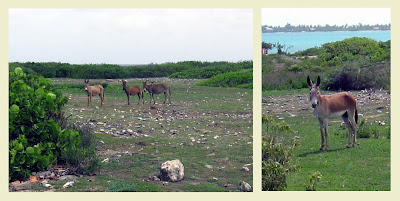Unlike volcanic Caribbean islands with their lush mountains and rainforests, Barbuda is formed of limestone. It’s flat and rocky, covered with scrub, sea grape, and the occasional group of palm trees. The description so far seems a little sketchy, doesn't it? Stay tuned.
On approach, from four miles out,
the island seems to appear out of nowhere.
Most of the coastline of Barbuda is, quite simply,
mile after mile of beach surrounded by acres of reef.
Our first stop was Coco Point and Pink Beach.
There’s no shelling here. The beach is astoundingly clean. Not a shred of grass or seaweed on the beach or in the water.
And then there’s 11 Mile Beach at Low Bay on the west coast. Once again, photos can’t possibly show the scope of the beach. Eleven miles. Unbelievable.
The sand at the water line here is tinged pink
by tiny bits of red coral, the same as at Pink Beach.
Available light and camera angle affect the intensity
of the colour, but it's unmistakeable.
And the water is so clear, we could see Bruce at work,
here in about 15 feet of water.
We were anchored centrally in Low Bay,
right off one of the few resorts on the island.
The Lighthouse Beach Resort is quite new and the base
for a planned development of private ‘cottages’
running north from the resort.
It seems that Barbudans are not particularly in favour
of tourist development. We like their thinking.
We joined the crew of Moerae for a tour of the famed
Frigate Bird Sanctuary in Codrington Lagoon.
From left to right, meet dad Alphonse, 15-month-old Alfie,
and guide extraordinaire, George Jeffrey.
Frigate birds are flying machines - they can’t swim and can barely walk. With the largest wingspan-to-body-weight ratio of any bird, these guys can stay aloft for as long as a week when migrating.
These birds are monogamous for the mating season
of September through April and generally,
just one egg is laid per breeding season.
The male frigate bird inflates its red throat pouch to attract a female.
Rearing a frigate bird chick can take longer than a year.
There were fewer birds, especially fewer males,
when we were there in May, but no matter –
getting so close to these endangered birds was thrilling.
And we enjoyed an adventure ashore a few weeks later.
Solomon picked us up in his water taxi ……
…… and joined us, with our tour guide, Nkosi,
for a look at the east coast of Barbuda and the limestone caves.
The limestone formations that house the caves are stark and beautiful.
The locals come to the caves to camp.
Geoff went ahead as we ascended through one cave and Nkosi had my back.
The look on my face tells you how thrilled I was with the
darkness, the sharp incline, and the questionable footing
– some of my favourite things.
Fortunately I was wearing my hiking flip flops.
But when we emerged into full daylight in the highland area?
The view of Two Foot Bay was worth the climb.
And a caveat here - this wasn't exactly mountain climbing. The highest point in Barbuda is all of 125 feet.
Another stop was the Highland House ruins,
part of the former Codrington Estate.
In the 1600s, England leased Barbuda to the Codrington family. They used the island primarily to breed slave labor for their sugar plantations on Antigua. Nkosi and I talked about the history a bit, then had a ‘that was then, this is now’ moment.
We may have to adopt Nkosi.
On the drive back to Codrington for lunch,
Nkosi and Solomon showed us the sand mines.
Barbuda exports sand by barge to neighbouring islands.
We walked around Codrington for a bit, the only town on Barbuda, and home to most of the island’s inhabitants. Various sources put the population somewhere between 1500-1800 people.
Codrington meanders with good town roads that
evolve into dirt roads as the city turns into rural space.
Horses are a big part of Barbudan life
and are left to wander freely throughout the town.
Next year, we plan to check out the Sunday horse racing.
And this is the Art Café in Codrington, the home
and business of Claire Frank and her husband, Mackenzie.
We chatted with Mackenzie,
but Claire was away in England.
but Claire was away in England.
We hope to meet her next year.
Claire is one of the forces behind the website www.barbudaful.net.
The next anchorage for Beach House was Gravenor Bay
on the southeast corner of Barbuda.
The multiple reef systems and coral heads make for a tense approach. We had good waypoints from fellow cruisers and Geoff stood look out on the bow as we slowly worked our way in to this astounding anchorage.
We did a dinghy tour the next day around Gravenor Bay.

And another day the captain did a little snorkeling ......
...... while I kept watch on the dinghy.
We did some exploring ashore as well, walking inland just a bit to the Codrington family’s castle ruins.
The castle was built in 1666 and destroyed by an earthquake.
Just a short walk from Gravenor Bay is this southernmost view of the wild Atlantic coast of Barbuda. Studded between these rugged limestone outcroppings are snippets of beach.
On the way back to the dinghy, we came upon a few of the wild donkeys that roam the island.
The distinctive raspy braying of these shy animals made us smile every morning. No need for alarm clocks.
When people ask which island is our favourite, we now have an answer. We’ll go back to Barbuda next year to revisit some favourite spots, and to search out some new adventures.
And, of course, there are miles and miles of beach
yet to explore.
yet to explore.







































